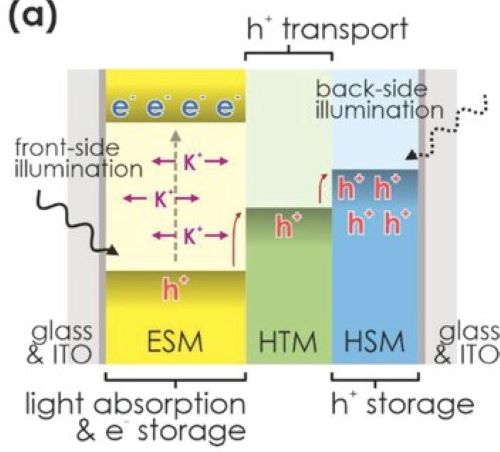Solar batteries, combining both solar cells and batteries in the same device, are a novel decentralized and integrated approach to renewable energy supply. Such a design is proposed to minimize losses caused by charge extraction from the solar cell, wiring, and voltage or current mismatch.
Researchers at the Max Planck Institute for Solid State Research in Germany have explored the optical design characteristics of a solar battery based on earth-abundant and cheap 2D polymeric carbon nitride as the photoanode.
To do this, the team first had to find a way to deposit a thin layer of 2D carbon nitride potassium, poly(heptazine imide), K-PHI, which normally comes in a powder form or in aqueous suspensions of nanoparticles. Then, they carried out optic simulations and experiments to take a closer look at the efficiency limitations and design considerations of their solar battery.
Being semi-transparent, the solar battery can absorb light on both sides. Specifically, it sandwiches a series of layers of semi-transparent materials with different functionalities between two high-transparency, conductive glass layers.
By calculating the absorptance within the solar battery comprising different K-PHI active layer thicknesses and the corresponding polystyrene sulfonate hole storage material layer, the researchers found that illumination through the rear of the device is superior irrespective of active layer thickness, as long as the collection layer is thinner than the active layer.
They also found that thinner active layers lead to larger photocharging currents (better solar cell functionality), but with a lower electric capacity (worse battery functionality).
The research team also reported that their device displays great versatility. It enables both large, one-off currents and smaller currents, which could be sustained over a longer time, typical of the requirements of mobile phones.
“We show how energy output increases most significantly for small electric discharging currents which are in the range of the photocharging current generated via illumination. This leads us to conclude that only minor light intensity increases can lead to major performance boosts,” the researchers write in Bridging the gap between solar cells and batteries: Optical design of bifunctional solar batteries based on 2D carbon nitrides published in Advanced Energy Materials.
They added that the results presented in the paper are transferable to other solar battery concepts, such as photocapacitors or solar redox flow batteries, which both utilize bifunctional electrodes or have separated light absorption and charge storage material heterojunctions.
This content is protected by copyright and may not be reused. If you want to cooperate with us and would like to reuse some of our content, please contact: editors@pv-magazine.com.




1 comment
By submitting this form you agree to pv magazine using your data for the purposes of publishing your comment.
Your personal data will only be disclosed or otherwise transmitted to third parties for the purposes of spam filtering or if this is necessary for technical maintenance of the website. Any other transfer to third parties will not take place unless this is justified on the basis of applicable data protection regulations or if pv magazine is legally obliged to do so.
You may revoke this consent at any time with effect for the future, in which case your personal data will be deleted immediately. Otherwise, your data will be deleted if pv magazine has processed your request or the purpose of data storage is fulfilled.
Further information on data privacy can be found in our Data Protection Policy.